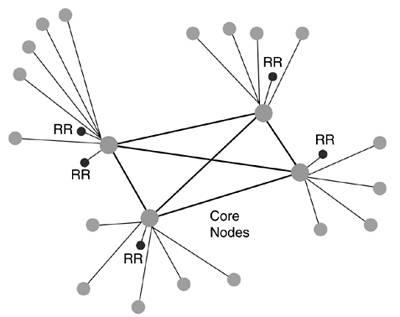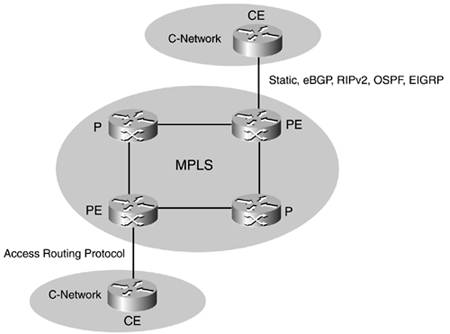IP Routing Protocols
| This section touches on the subject of IP routing in an MPLS context. The MPLS paradigm builds on existing IP routing technologies, so there are few new IP routing concepts. In-depth IP routing is outside the scope of this book. The books OSPF Network Design Solutions and IS-IS Network Design Solutions from Cisco Press offer in-depth analysis of the two interior routing protocols used the most in MPLS environments. This section covers interior routing protocol concepts in an MPLS domain, as well as some BGP route reflector and access routing protocol ideas needed in MPLS VPN environments. Interior Gateway ProtocolTheoretically, any IGP can be used in an MPLS environment. Link-state protocols such as Open Shortest Path First (OSPF) and Intermediate System-to-Intermediate System (IS-IS) are needed for MPLS traffic engineering (TE) applications. They are also the choice of most ISPs. Today, from a Cisco perspective, features available for OSPF and IS-IS are very similar, if not identical. Link-state technology ensures the fastest convergence that is loop-free in terms of route calculation. From an operational point of view, link-state protocols are easier to troubleshoot because all routers have the same link-state database. In particular, the advantage of IS-IS over OSPF is that a router inserts all the prefixes it announces on a single protocol packet. Therefore, it is easier to find all the routing information announced by a particular router. IS-IS also has scalability and reliability advantages over OSPF:
iBGP and Route ReflectorsIn an MPLS VPN environment, iBGP sessions need to be set up among all Provider Edge (PE) routers. A full iBGP mesh is required among all PEs that need the same VPN information. Route reflectors (RRs) provide scalability and ease of management in that respect. RRs have the following advantages:
RRs are recommended to be dedicated routers similar to PE routers, such as Cisco 72xx routers, as shown in Figure 5-5. Figure 5-5. Route Reflectors Connected to the Core
In Figure 5-5, peering is configured between a PE to each of the four RRs. This means that each PE has four neighbor statements. If not for the RRs, you would need to configure neighbor statements to all the PEs in the network. A router, or pair of redundant routers, dedicated for route reflector functionality and not in the forwarding path allows for faster convergence by saving CPU and memory. You can improve BGP convergence and scalability by grouping neighbors with the same update policies into peer-groups, making update calculations more efficient (by reducing the number of times the BGP table needs to be walked) and also lowering CPU and memory requirements. Increasing the input hold-queue and the maximum segment size (MSS) can also improve the BGP performance. This last case will be covered in Chapter 7, "Practical Applications of MPLS." Access Routing ProtocolsAs shown in Figure 5-6, access routing defines the routing protocol between the edge LSR (PE router) and a CE router. The following VPN-aware access routing protocols are supported: static, eBGP, OSPF, RIP2, and EIGRP. Figure 5-6. Access Routing Between the PE and CE Routers
When connecting PE to CE devices, BGP, RIPv2, and static routing use separate routing contexts for each VRF, and OSPF uses separate routing processes per VRF. Most CPE routers are connected to the core through static routes. This is true of small VPN sites where the routing table has few routes. Using static routes would provide a significant advantage for security, but it would require manual intervention to configure the static routes. Dynamic routing could be offered as an additional service option, allowing the customer to dynamically change his network addressing. If dynamic routing were implemented, eBGP would be the preferred routing protocol when customers are dual homing to multiple PEs or when a large number of routes is present. |
EAN: 2147483647
Pages: 149

